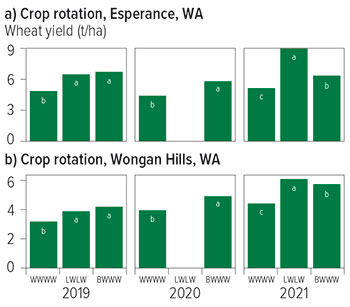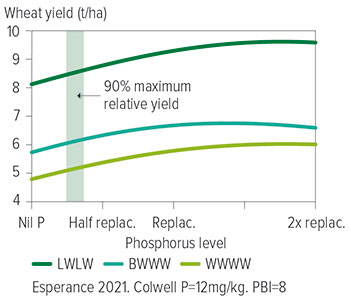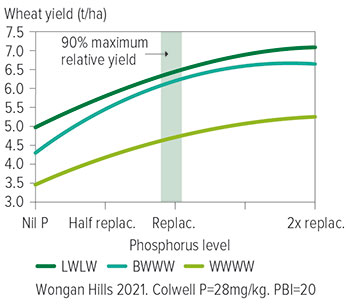Unlocking legacy phosphorus may be a key to improved sustainability of cropping systems.
Recommendations thus far
- Consider means of enhancing phosphorus recycling and microbial phosphorus turnover to mobilise legacy soil phosphorus to reduce phosphorus inputs
- Consider brown manuring legume crops or including legumes or pulses in rotation to improve phosphorus cycling and enable crops to access legacy soil phosphorus
Continued phosphorus fertiliser applications beyond what is removed in produce have led to a build-up of residual phosphorus in Western Australian soils.
With escalating fertiliser costs and increasing concerns about the sustainability of cropping systems, attention is being trained on improving the understanding of ‘legacy’ soil phosphorus and what could be done to improve access to this resource by crops.
As part of a large GRDC investment led by Dr Craig Scanlan (WA Department of Primary Industries and Rural Development) on nitrogen, phosphorus and potassium fertilisers, Dr Gustavo Boitt, who is based at the University of Western Australia, is applying his soil science expertise to this issue.
With training covering subtropical cropping environments in Brazil and temperate environments in New Zealand, coupled with detailed soil biogeochemistry skills, Dr Boitt is delving deep into the chemistry of WA’s highly weathered soils to generate new knowledge on phosphorus dynamics.
“Phosphorus is a key nutrient required for plant growth. Phosphate rock reserves – the primary material for phosphorus fertiliser manufacture – are a finite, non-renewable resource. Around 80 per cent of rock phosphate is localised in the Morocco region and Australia is highly reliant on phosphorus fertiliser imports to meet its demands,” Dr Boitt says.
“Australia’s ancient soils are highly weathered like Brazil’s and this results in phosphorus-limiting conditions that require phosphorus additions for productive agriculture.
“To tackle this situation and improve crop productivity, we need to have a complete understanding of the chemical nature of phosphorus and changes that are occurring for different phosphorus forms in soils that control phosphorus availability to crops.”
Complex phosphorus dynamics
Phosphorus is present in soils in different organic and inorganic pools. The organic phosphorus forms or chemical species found in soils include phytate, phospholipids and nucleic acids such as DNA, while inorganic species include phosphorus fixed on to clay minerals and precipitated as aluminium, iron or calcium phosphates of poor solubility.
The availability of phosphorus to plants depends on the chemical forms present in a given soil and the equilibrium between them.
Phosphorus fertiliser inputs over the years result in phosphorus accumulation in inorganic and organic pools and these can become available through the processes of mobilisation.
Following the addition of phosphate fertiliser, phosphorus will rapidly interact with the soil components such as oxides and clays. Sometimes these reactions can take many years, or decades, to be reversed and this explains why maintenance rates of phosphorus fertilisers are generally required.
Soil microbes and plant roots can free phosphorus that has formed stable compounds with organic matter by the action of enzymes called phosphatases, whereas inorganic phosphorus compounds can be solubilised in response to changes in soil pH.
“It is paramount that we know the nature of the accumulated phosphorus in soils, together with the chemical and microbial processes involved in delivering available phosphorus to crops. This knowledge will ultimately pave the way for efficient nutrient management practices, improved return on the soil phosphorus investment and increase the resilience of growers towards phosphate fertiliser market price instability,” Dr Boitt says.
Field knowledge
DIPIRD’s phosphorus trials have been running for four years at two contrasting climatic sites – Esperance (average annual rainfall 578 millimetres) and Wongan Hills (354mm) from 2018 to 2021. Soils at both sites have a loamy-sand texture and had received phosphorus fertiliser inputs for many years.
“With these field experiments, we aimed to determine the impacts of phosphorus application rates, crop rotation systems and soil management on grain yields.”
The crop rotation systems evaluated were either continuous wheat for four years (indicated as “WWWW”), rotation of narrow-leafed lupins and wheat ("LWLW”) or brown manuring with a faba bean crop in the first year (2018) followed by three consecutive years of wheat crop (“BWWW”).
Phosphorus treatments tested were nil phosphorus and various replacement rates (half, full and two-fold) drilled each year. Furthermore, the addition of lime and deep ripping before sowing in 2018 in comparison to untreated plots was tested.
Figure 1 shows the wheat grain yield responses by crop rotation treatment at both sites during the years of the trials.
Figure 1: Wheat grain yield responses as an effect of crop rotation treatments at Esperance (a) and Wongan Hills (b). The bars represent the mean values for each treatment. For each year, lower-case letters indicate significant differences between means (Fisher’s LSD test, α = 0.05).

Source: Gustavo Boitt, UWA
The effects of brown manuring were evident at both sites and the benefits extended for the three following years. At the Esperance trial, wheat yield was 38 per cent higher in the first year (2019) following brown manuring in comparison to wheat after wheat.
The residual effects of brown manuring were still significant in the second and third wheat crops, with increases of 32 and 23 per cent, respectively, compared to wheat monocropping. Rotating lupins and wheat was shown to increase the yield of the following wheat crop by 33 per cent, and up to 74 per cent, on average in 2019 and 2021, respectively, compared to wheat alone.
The research team working on these trials has eliminated differences in nitrogen supply from lupin or wheat residues by adjusting the level of nitrogen applied on a plot-by-plot basis.
At the Wongan Hills site, brown manuring increased grain yields of following wheat from 24 to 33 per cent, with clear effects even after three years. Following a lupin crop, wheat yields were 24 and 38 per cent higher in 2019 and 2021, respectively, compared to sequential wheat crops at this site.
“Combined, the results of these experiments show high wheat yields can potentially be achieved by introducing legume species, such as lupins, in the crop rotation systems and brown manuring as an effective way of enhancing phosphorus mobilisation and recycling,” Dr Boitt says.
Figure 2: Wheat grain yield responses to different levels of phosphorus fertiliser applied in different crop rotation systems in 2021 at Esperance, WA. Data presented are means and standard deviations for each treatment. The highlighted grey area is the calculated range of phosphorus rates for 90 per cent of maximum yield.

Source: Gustavo Boitt, UWA
“For instance, in Esperance plots without phosphorus fertiliser applied, phosphorus uptake by wheat at flowering was 91 per cent higher in 2019, the first year after brown manuring, and 47 per cent higher after a lupin crop compared to wheat followed by wheat.
"Similar trends were observed at Wongan Hills with 53 per cent higher phosphorus uptake by wheat following the brown manure and 26 per cent higher following lupins. This increased accumulation of phosphorus translated to higher wheat grain yields as well.
“Additional to exploitation of different soil phosphorus pools by diverse crop rotation, there will also be further soil health benefits, interruption of pathogen cycles and improved control of invasive plant species, so the whole system benefits.”
Figures 2 and 3 show wheat yield responses to different rates of phosphorus applied in different crop rotation systems. The agronomically optimal phosphorus rates to reach 90 per cent of maximum wheat yield varied from less than the half replacement (in Esperance) to about replacement levels (in Wongan Hills), but the responses were highly dependent on the crop rotation system employed.
Figure 3: Wheat grain yield responses to different levels of phosphorus fertiliser applied in different crop rotation systems in 2021 at Wongan Hills, WA. Data presented are means and standard deviations for each treatment. The highlighted grey area is the calculated range of phosphorus rates for 90 per cent of maximum yield. Source: Gustavo Boitt, UWA

Source: Gustavo Boitt, UWA
Dr Boitt is quantifying various chemical and microbial processes contributing to soil phosphorus availability using a combination of high-resolution chemical characterisation and DNA analysis at these two trials.
Chemical knowledge
Dr Boitt is focused on elucidating the long-term impacts of land management on crop phosphorus use efficiency and soil phosphorus dynamics.
He has been using a combination of cutting-edge techniques such as phosphorus nuclear magnetic resonance (31P NMR) and synchrotron-based approaches to fully characterise organic and inorganic phosphorus forms in a range of WA soils.
“Up-to-date knowledge of the chemical nature of phosphorus in soils from the WA wheatbelt is non-existent and such chemical characterisation will underpin more-effective rotation systems with enhanced crop phosphorus use efficiency and increased grain yields with decreased phosphorus fertiliser inputs,” he says.
More information: Dr Gustavo Boitt, 08 6488 2776, gustavo.boitt@uwa.edu.au

























































